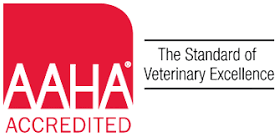Dental Care in a Pet-Friendly Space

Keep your pet’s breath smelling clean and fresh with regular dental care visits at Evendale-Blue Ash Pet Hospital. Just like their owners, our furry friends need a consistent dental routine that includes daily brushing at home and professional dental exams to limit the buildup of plaque and prevent oral disease.
At Evendale-Blue Ash we always check your pet’s teeth and gums during their annual wellness exam, but we still recommend a full dental exam in order to perform an in-depth check of your pet’s mouth to diagnose any signs of tooth decay, bleeding gums, or oral infection.
Dr. Goodman also checks for gingivitis and periodontal disease during the dental exam. We use dental x-rays to get a clear picture of your pet’s teeth, gums, and mouth and use general anesthesia to conduct a thorough exam of all the oral cavities. We understand that anesthesia makes pet owners nervous, but it is the most effective way to ensure we get a good look at everything going on in your pet’s mouth.
Comprehensive Oral Health Assessment and Treatment
A comprehensive oral health assessment and treatment (COHAT) involves a thorough examination and management of your fur-babies oral health. Let’s break down what happens during your pet’s procedure:
1. Pre-Anesthetic Evaluation:
- We will gather information about your pet’s overall health and create a treatment plan based on the Veterinarian’s assessment of what will likely need to be done to help restore or maintain your pet’s oral health.
- On the day of the procedure the Veterinarian will assess your pet to ensure they are fit for anesthesia that day.
2. Anesthesia and Monitoring:
- Your pet will be placed under general anesthesia to allow the veterinary team to fully assess every tooth.
- A dedicated team member will continuously monitor vital signs (heart rate, respiratory rate, oxygenation, etc.) throughout the procedure.
- A procedure may take 40 minutes up to a few hours, depending on the level of oral treatments your pet needs.
3. Dental Radiographs:
- Once your pet is under anesthesia, we take X-rays to assess the health of tooth roots and bone structure and detect hidden dental disease (e.g., abscesses, and bone loss).
4. Oral Examination:
- The veterinary team evaluates the teeth, gums, and oral tissues for signs of disease such as plaque, tartar, gingivitis, fractures, and oral masses.
- The veterinarian utilizes a periodontal probe to meticulously explore for pockets and assess the extent of attachment loss surrounding the teeth.
5. Dental Scaling and Polishing:
- Ultrasonic Scaling is used to remove plaque and calculus (tartar) from the tooth surfaces above and below the gumline.
6. Periodontal Treatment:
- Subgingival Scaling or root planning cleans and smooths the root surfaces below the gumline to remove bacteria and prevent further periodontal disease.
7. Tooth Extraction:
- Teeth that have severe disease, such as an abscess or significant bone loss may require extraction.
- Surgical techniques such as sectioning of the roots or elevation of gingival tissue around the tooth may be employed for complex extractions.
8. Home Care Recommendations:
- Once your pet’s procedure is complete, a member of our surgery team will review discharge information with you.
- We will discuss any home-care needed, such as administering pain medication, or feeding guidelines, as well as go over all the findings and treatments from the procedure.
- You will have a chance to ask questions and we will make sure you feel comfortable with caring for your pet at home.
- There are several home-care products approved by the Oral Health Council we will recommend to slow down the progression of future dental disease.
- VOHCA Accepted Products for Cats
- VOHC Accepted Products for Dogs
- By following these steps, we provide comprehensive oral health care tailored to each pet's needs, ensuring optimal dental health and overall well-being.
To find out if your pet needs a dental cleaning or oral surgery, please schedule an appointment for a dental consultation.










